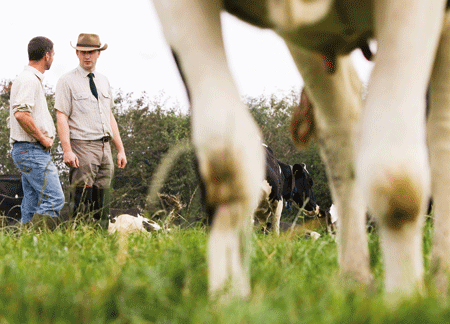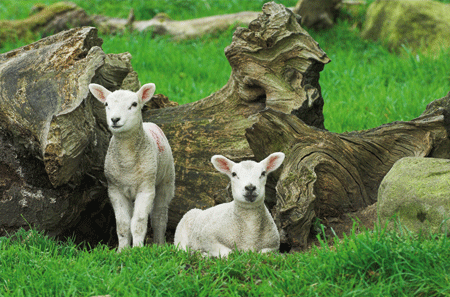Farm health planning: All you need to know

Better fertility and more calves, improved housing and less pneumonia and mastitis, better biosecurity and less disease – these are just some examples of what has been achieved on the beef and dairy farms which took part in the Defra-funded Herd Health Planning initiatives, organised by XLVets.
These farms are just completing the end of 12 months of proactive health planning through their XLVets vet practice. During this time, herds have benefited from disease-testing, fertility testing, and also advice on herd management and nutrition from independent consultants, working closely with the farm’s vet and the farmer and/or herdsman and often sharing their experiences with others through on-farm walks and discussions groups.
On each farm, the starting point has been to assess what the current situation is on farm, before prioritising which areas to focus on. Following the “Measure, Manage, Monitor” approach, once changes have been made and improvements seen, the situation is then being monitored on an ongoing basis. Different circumstances – weather, feed quality, stress, environment – can alter the production challenges, month by month, year by year.
Assessing the risks from new or existing disease and implementation of biosecurity measures have been issues across beef and dairy farms, and have proven particularly topical with the advent of bluetongue in the UK. Vet Steve Borsberry from the 608 Vet Group says: “Through blood sampling and/or bulk milk testing, evidence has been obtained of the degree of infection in the herd for diseases like BVD, IBR and leptospirosis. Some herds have tested totally naïve to certain diseases – whether or not to vaccinate as a precaution, or establish tight biosecurity is a decision which is made between the farmer, herdsman and the vet involved.”
Blanket vaccination of all animals could be the proposal, as complete biosecurity is often impossible – for example the times when animals end up sharing grazing with uninvited four-legged visitors from neighbouring farms, he adds.
Beef health
Vet Keith Cutler from the Endell Vet Group and last year’s Farmers Weekly’s Livestock Adviser of the Year is running one of the XLVets beef projects. He says vets have traditionally got more involved with working in dairy herds, however, health planning is just as important on beef enterprises.
“For beef suckler herds, the key output is the calf. So profit is directly related to the number of calves born in a herd – and this is dictated by the health of the herd – in particular the fertility of the bull and cows.
“As a starting point in any health planning, basic performance data is collected. For beef suckler herds this includes the number of calves born per year, the ratio born live:dead, calf losses from birth to weaning, and a calculation of growth rates from the difference between weights at weaning and slaughter.”
Using this information the herd can then be benchmarked against other farms to assess whether performance is already near peak potential or whether there is scope for improvement. It’s possible to find out where maximum gains for a set input can be achieved. Efforts can then be targeted in those specific areas.
“Farmers shouldn’t be put off by the task of starting up herd health planning, it just requires the involvement of the farm’s vet and a proactive joint approach. Just don’t try and tackle too many things in one go. Instead, start planning in bite-sized pieces and make progress on one area of health before moving onto the next one,” adds Mr Cutler.
Other key areas of focus for beef suckler herds involved in the XLVets initiatives have been tightening of the calving block, testing bull fertility and soundness, and herd management changes, for example, improving handling facilities and culling aggressive animals. Herd nutrition is another area where attention to the detail has helped ensure mineral requirements are met, and forage quality analyses have enabled more effective use of home-grown feeds and better balanced rations.
Dairy Health
Overseeing the XLVets’ dairy projects is Brian Pocknee of ADAS, who can’t stress enough that the healthier the herd, the better its performance and the better the margins.
“On dairy units, like any business, there are areas in which little extra improvement can be made, and at the same time areas which could benefit from a focus on improving. For dairy farmers, key herd health issues often centre on reducing the incidence of mastitis or improving fertility. However, the various dairy projects have also encompassed the role of nutrition in health issues. Vets, farmers and nutritionists have collaborated to bring about change – this team approach is the foundation to successful herd health planning.”

Nutritionist Richard Vecqueray of Evidence-based Vet Consultancy has worked with several of the project farms. He thinks producers can rely too much on the nutritionist’s word and theory, and should also be auditing the nutritional status of the herd using blood testing and urine testing.
Blood samples should be taken regularly from a representative number of animals from a target group, explains Mr Vecqueray. “This is a job for the farm vet – the results of the tests can then be discussed between the vet and the nutritionist, along with the farmer.
“For instance, taking blood samples from dry cows allows urea levels to be measured to check rumen protein balance and intakes. Additionally, fat levels in the blood of dry cows are a measure of their energy status and indicate how well an animal will cope with the post-calving demands of milk production.
“There’s a lot of value for producers to sit down for a strategic overview of the herd’s health and performance, at least once a year, with their nutritionist, vet and any relevant specialists, depending on the specifics of the farm.”
Among the advisers made available to the dairy project farms was Ian Ohnstad of The Dairy Group, tasked with a particular focus on mastitis control.
Every farm had its own unique challenges, says Mr Ohnstad. “Some of the farms had a relatively small mastitis problem to control and just needed some fine tuning to milking routines, while others had more significant problems including environmental management.
“The advice needs to be dynamic. You implement what you consider to be appropriate changes to address the problems identified. Then you monitor the situation and if there’s no improvement then you re-evaluate and review your advice to ensure benefits are obtained.
“Herd health planning is recognising where the weaknesses exist within a system and implementing action plans to address them – it’s so much more than just reaching for treatments or a vaccine,” adds Mr Ohnstad.
XLVet comment, Andrew Curwen, chief executive XLVets
Herd health plans have had some pretty poor press in the past, often being used only as tick-box exercises to satisfy the requirements of farm assurance schemes.
However, the dairy and beef projects have been all about herd health planning – which is proactive and ongoing. Changes are made to improve health – the cost of which is nothing compared to the financial benefits that will result.
Getting started in health planning is easy: Talk to your vet, and agree the first steps. Decide where the health priorities lie for your herd, and set about taking action right away.
Flock health planning
Flock health planning for sheep farmers needn’t be prescriptive or restrictive, but must be based on measurable data, says Matthew Pugh of Belmont Vet Centre, Hereford.
“Knowing what’s being achieved when you start and having clear, achievable goals is key. On one farm I’m working with the data is excellent, but the results it details are less impressive.
“For the 2006 lambing, ewes scanned at 153%, but only 1.28 lambs were sold per ewe, while in 2007 ewes scanned at 183% and sold at 153%. So, a clear improvement has been made, but there is no one deciding factor which has made the difference.”

Nutrition at tupping and ewes’ trace element status were both part of the cause and both were investigated and solutions put in place, he explains. “But there was also a toxoplasmosis issue which was resulting in both abortions and weak lambs being born. A vaccination policy was implemented, but a vaccine breakdown in the first year saw a 9.4% abortion rate in 2007, compared to 4.9% in 2006.
“However, this year abortions, which were a particular problem among shearling ewes, haven’t been seen, so vaccination appears to be the way forward.”
Additionally, treatment protocols have been put in place for neonatal conditions such as joint ill and watery mouth, says Mr Pugh.
